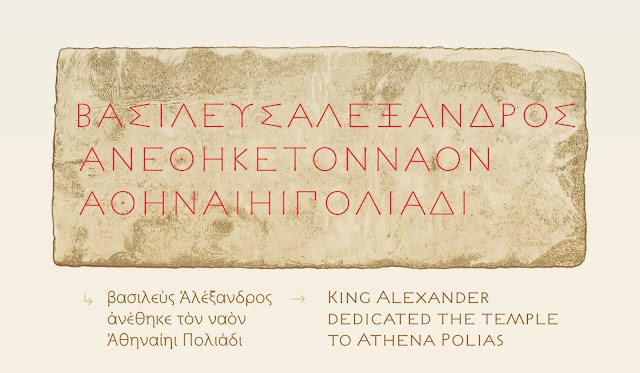Many inscriptions have been found in the ancient city of Priene, but only one of them is called the ‘Priene Inscription’. This inscription owes its fame largely to Alexander the Great and the story of Strabo.
First of all of all, some archeology and geography notes on the subject:
The subject of our article takes place in the new city of Priene with a Hippodamian (grid) plan in the Hellenistic period. The exact location of old Priene, which was originally a Carian settlement before the Ionians, is unknown.
This temple is one of the rare Hellenistic temples that have survived (not standing) to the present day without being renovated by the Romans.
Another outstanding feature is that the Temple of Athena Polias is the work of Pythius of Priene, who was also the architect of the Halicarnassus Mausoleum.
Judging by the Strabo narrative, the dedication by Alexander the Great of the new temple for Athena Polias in Priene is a rather interesting story.
334 BCE: Alexander of Macedon, who inherited a large army from his father Philip II, after winning the battle with the Achaemenids on the banks of the Granikos River (modern Biga River) which opened the gates of Asia to his army, visits the nearby Troy. He asks for permission from the graves of the heroes of the Trojan war to bless the war he waged against the Persian domination in Asia Minor. From there, he proceeds his advance from the west coast to the south, and continues to repel the Persians and Persian defenders who stand in his way.
When he reaches Ephesus, he learns that a Temple of Artemis will be built. The story is that the previous Temple of Artemis was destroyed by fire on the very day he was born. He sends a message to the leaders of the city at once. He promises to pay all of the construction cost in exchange for the engraving of his name on the wall of the new temple to be built. His offer was wisely declined, saying, “It is not fit that a god should provide temples in honor of gods.” Flattered, Alexander says, ‘thank you’ and goes about his business. The Ephesians would not have denied the honor of Augustus in a similar later situation.
Continuing his campaign, Alexander stumbles upon the construction of the temple of Athena Polias in Priene. He must not have given up on his wish to have his name inscribed on a temple wall. His offer will be accepted this time. According to epigraphic sources, Alexander gave Priene its freedom in 334 BCE. “He showered gifts on the city and the temple”.
After the temple was excavated in 1869–70 by the Society of Dilettanti, this block and several others from the adjacent wall were removed to London. We learn from the publications that started with the book of Chandler in 1769 that the in situ location of the inscription block was one of the antae of the temple. It is still in the British Museum.
This inscription is also remarkable in that it is the first known example of the name Alexander the Great carved into history on a stone because such examples will become more numerous in the future, and even cities are named with him.
The dedication inscription placed in the name of Alexander represents an innovation in the history of Greek architecture and religion. Temples were previously built by societies or individuals solely for the Gods, and although there are exceptions, their walls are usually not inscribed with the names, images, human qualities (such as heroism) or frailty (such as arrogance) of mortals. In Hellenistic culture, there is the concept of heroon (hero cult) for this. People can be heroized, but not deified. The concept of deification should not to be confused with sublimation. It is true that temples were built for the Gods. What leads to error is to interpret whether the tombs are temples or not, based on their external appearance. In Anatolia, the situation is just the opposite, and this inscription is not the only example attesting this.
Inscription:
ΒΑΣΙΛΕΥΣ ΑΛΕΞΑΝΔΡΟΣ ΑΝΕΘΗΚΕ ΤΟΝ ΝΑΟΝ ΑΘΗΝΑΙ ΠΟΛΙΑΔΙ
Translation:
King Alexander dedicated the Temple to Athena Polias.

















No comments:
Post a Comment